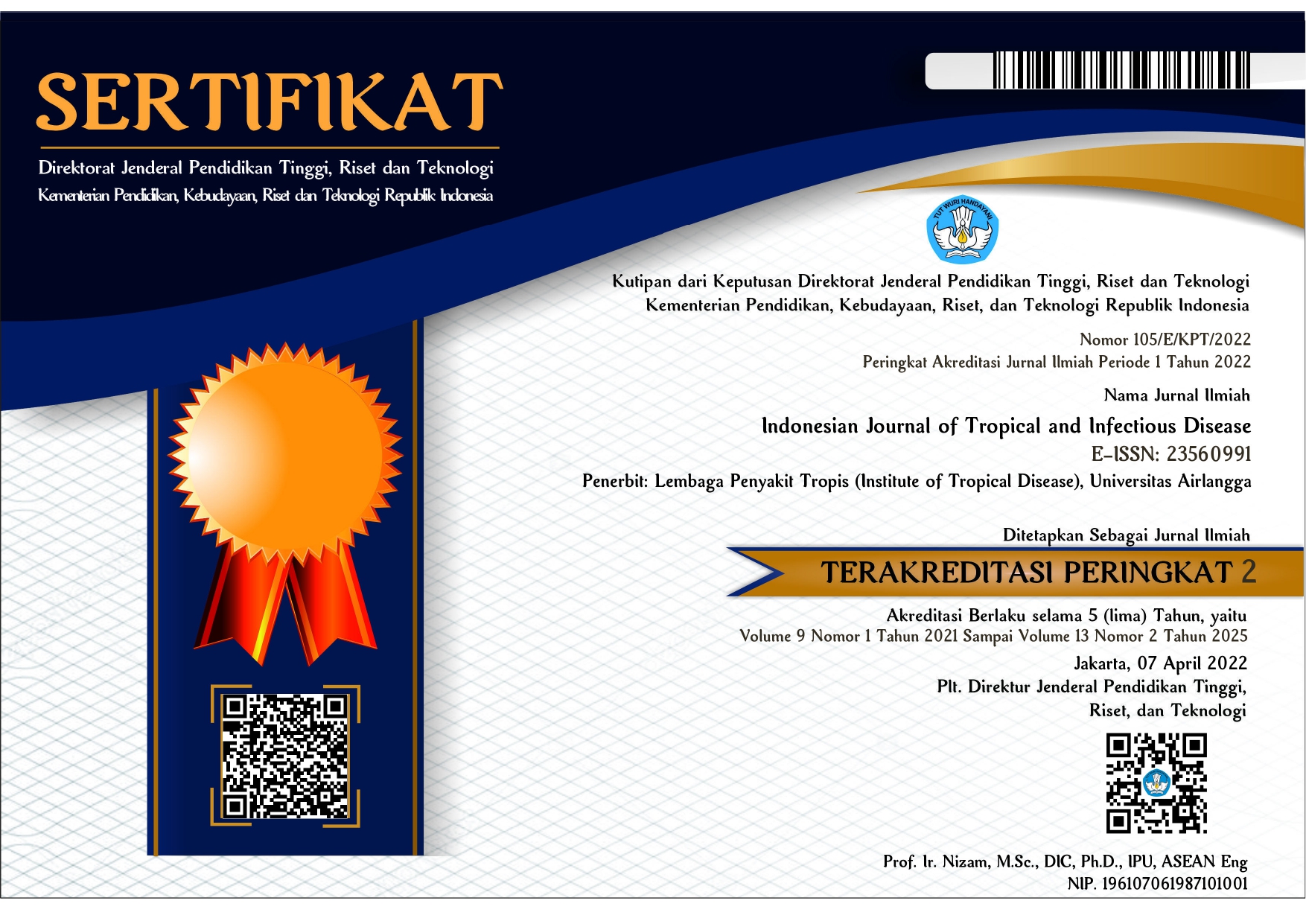Resistance Pattern of Anti-TB Drugs in Drug-Resistant TB of Pulmonary Tuberculosis Patients in Dr. Soetomo Academic Hospital, Surabaya, Indonesia
Downloads
Pulmonary tuberculosis is an infectious disease that can be transmitted through the air due to infection with Mycobacterium tuberculosis bacteria. According to the WHO, TB is the second-highest cause of death in infectious diseases in the world. This study aims to determine patterns of anti-TB drug resistance in drugresistant TB patients in Dr. Soetomo Academic Hospital from January 2022 to December 2023. This was a descriptive retrospective using patient medical record data in Dr. Soetomo Academic Hospital for the period January 2022 - December 2023. This study included 261 drug resistant pulmonary TB patients, the majority of whom were new TB patients (61.3%). Anti-TB drug resistance
was most prevalent in RR-TB (43.7%), with the highest number of new cases (28.4%). Drug susceptibility test showed High-dose Isoniazid (INHHD) had a high resistance rate (56%). Isoniazid (H) had a high resistance rate (66%). Pyrazinamide (Z) showed high sensitivity (66%). Levofloxacin (Lfx) showed high sensitivity (89%). High-dose Moxifloxacin (MfxHD) high sensitivity level (94%). Moxifloxacin (Mfx) high sensitivity level (92%). Bedaquiline (Bdq) high sensitivity level (98%). Linezolid (Lzd) high sensitivity level (99%). Clofazimine (Cfz) high sensitivity level (97%). Amikacin (Amk) high sensitivity level (100%). Drug-resistant pulmonary TB patients recently show a high drug sensitivity pattern to the second-line anti-TB drugs. MTB has become resistant to Isoniazid. However, it is still sensitive to Pyrazinamide by 66% and Levofloxacin by 89%. Moxifloxacin, Bedaquilin, Linezolid, Clofazimine, and Amikacin have high sensitivity >90%.
Siregar PA, Farashati JI, Syafira AC, et al. Konsep Epidemiologi Terjadinya Penyakit Tuberkulosis. Zahra: Journal of Health and Medical Research. 2023;3(3):462-70.
World Health Organization (WHO). Global Tuberculosis Report 2023 [Internet]. 2023. Available from: https://www.who.int/teams/global-tuberculosis-programme/tb-reports/global-tuberculosis-report-2023
World Health Organization (WHO). TB Day 2022 Fact Sheet [Internet]. 2022. Available from: https://www.who.int/indonesia/news/campaign/tb-day-2022/fact-sheets#:~:text=TB%20adalah%20penyebab%20kematian%20terbesar,di%20atas%20HIV%2FAIDS
World Health Organization (WHO). Health Data Overview for Republic of Indonesia. [Internet]. 2021. Available from: https://data.who.int/countries/360
Kementerian Kesehatan Republik Indonesia. Program Penanggulangan Tuberkulosis Tahun 2022. 2023. Available from: https://www.tbindonesia.or.id/wp-content/uploads/2023/09/Laporan-Tahunan-Program-TBC-2022.pdf (2023)
Sudirman S, Kolupe V, Assa AA, Purwiningsih S, Susianawati D. Implementation of the Pulmonary TB Control Program: Qualitative Study at Parigi Primary Healthcare. JPP. 2024;7(4):694-03.
Siregar SR. Extensively Drug Resistant Tuberculosis (XDR TB). Averrous: Jurnal Kedokteran dan Kesehatan Malikussaleh. 2019;5(2):26–43.
Ritonga IL, Manurung AP. Faktor-Faktor Penyebab Kegagalan Pengobatan TBC Pada Penderita TBC Di RSU Imelda Pekerja Indonesia. JIKI. 2022;8(2):107-112.
Saputra HL, Yulendasari R, Kusumaningsih D. Faktor-faktor yang berhubungan dengan Multidrug Resistant Tuberculosis (MDR-TB) pada pasien tuberkulosis paru. Holistik Jurnal Kesehatan. 2022;16(6):516–28.
Swain SS, Sharma D, Hussain T, Pati S. Molecular mechanisms of underlying genetic factors and associated mutations for drug resistance in Mycobacterium tuberculosis. Emerging Microbes & Infections. 2020;9(1):1651–63.
DeCooman D, Metzler K. Selective Pressure: Definition, Types & Example. Science Courses [Internet]. 2022 [cited 2023 Nov 21]. Available from: https://academy/course/introduction-to-biology.html
Kementerian Kesehatan Republik Indonesia. Lampiran Keputusan Menteri Kesehatan Republik Indonesia : Pedoman Nasional Pelayanan Kedokteran Tata Laksana Tuberkulosis. 2019. Available from: https://yankes.kemkes.go.id/unduhan/fileunduhan_1610422577_801904.pdf
Koh WJ, Lee H, Jeon D, et al. Drug-resistant tuberculosis: Challenges and advances. Lancet Infect Dis. 2021;21(3):301-308.
Vasquez JM, Lee M, Kwon Y, et al. Outcomes and predictors of multidrug-resistant tuberculosis treatment: A 5-year cohort study. J Clin Tuberc Other Respir. 2023;31:100320.
World Health Organizaation (WHO). Global Tuberculosis Report 2024. [Internet]. 2024. Available from: https://www.who.int/teams/globaltuberculosis-programme/tbreports/global-tuberculosis-report2024
Subramanyam B, Sivaramakrishnan G, Sangamithrai D, et al. Reprocessing of Contaminated MGIT 960 Cultures to Improve Availability of Valid Results for Mycobacteria. International Journal of Microbiology [Internet]. 2020 Jul 18;2020(1):1–3. Available from: https://onlinelibrary.wiley.com/doi/10.1155/2020/1721020
Maningi NE, Malinga LA, Antiabong JF, Lekalakala RM, Mbelle NM. Comparison of line probe assay to BACTEC MGIT 960 system for susceptibility testing of first and second-line antituberculosis drugs in a referral laboratory in South Africa. BMC Infectious Diseases [Internet]. 2017 Dec;17(1). Available from: https://pmc.ncbi.nlm.nih.gov/article s/PMC5745758/
Tekin K, Albay A, Simsek H, Sig AK, Guney M. Evaluation of the BACTEC MGIT 960 SL DST Kit and the GenoType MTBDRsl Test for Detecting Extensively Drugresistant Tuberculosis Cases. The Eurasian Journal of Medicine [Internet]. 2017 Oct 25;49(3):183–7. Available from: https://pmc.ncbi.nlm.nih.gov/articles/PMC5665627/#t1-eajm-49-3-183
Janah AN, Najmah N, Setiawan Y, Idrus M, Fajri R, Murniati H, Aprina, F. Hubungan Status Pengobatan dan Riwayat Pengobatan Sebelumnya Terhadap Keberhasilan Pengobatan Pasien TBC Usia Produktif di Kota Palembang. Manuju. 2023 Dec 1;5(12):4472– 4484. Available from: https://ejurnalmalahayati.ac.id/index.php/manuju/article/view/12780
Nurmala QP, Habib I, Nugroho H. Relationship between Tuberculosis Treatment History and the Incidence of Multidrugs Resistant Tuberculosis (MDRTB). 2024 Nov 20. Available from: http://repository.umy.ac.id/handle /123456789/33711
Seddon JA, Donald PR, du Toit E, et al. Emergence and epidemiology of drug-resistant tuberculosis. Lancet Respir Med. 2022;10(7):587-600. 22. Xu H, Li Q, Wang F, et al. Isoniazid resistance mechanisms in Mycobacterium tuberculosis and their role in clinical resistance. Front Microbiol. 2022;13:789345.
Vidal L, Pavan E, Soni S, et al. Fluoroquinolone resistance in Mycobacterium tuberculosis: Mechanisms, clinical consequences, and implications for treatment. Clin Microbiol Rev. 2022;35(4):e0019821.
Ginsburg AS, Gupta R, Steingart KR, et al. Global epidemiology of tuberculosis and progress toward ending the tuberculosis epidemic. Lancet. 2023;401(10382):1112-1124.
World Health Organization (WHO). Technical manual for drug susceptibility testing of medicines used in the treatment of tuberculosis. [Internet]. 2018. Available from: https://www.who.int/publications/i/item/9789241514842
Dartois VA, Rubin EJ. Antituberculosis treatment strategies and drug development: Challenges and priorities. Nature Reviews Microbiology [Internet]. 2022 Apr 27;20:685–701. Available from: https://pubmed.ncbi.nlm.nih.gov/35478222/
Alffenaar JWC, Stocker SL, Forsman LD, Garcia-Prats A, Heysell SK, Aarnoutse RE, et al. Clinical standards for the dosing and management of TB drugs. The International Journal of Tuberculosis and Lung Disease: The Official Journal of the International Union Against Tuberculosis and Lung Disease [Internet]. 2022 Jun 1 [cited 2023 May 21;26(6):483–99. Available from: https://pubmed.ncbi.nlm.nih.gov/35650702/
Limenh LW, Kasahun AE, Sendekie AK, Seid AM, Mitku ML, Fenta ET, et al. Tuberculosis treatment outcomes and
associated factors among tuberculosis patients treated at healthcare facilities of Motta Town, Northwest Ethiopia: a fiveyear retrospective study. Scientific reports [Internet]. 2024 Apr 2;14(1). Available from:https://pubmed.ncbi.nlm.nih.gov/38565912/
Vishwakarma D, Gaidhane A, Sahu S, Rathod AS. Multi-Drug Resistance Tuberculosis (MDRTB) Challenges in India: A Review. Cureus. 2023 Dec 9;15(12):e50222. Available from: https://pubmed.ncbi.nlm.nih.gov/38 192967/
Gopalaswamy R, Palani N, Viswanathan D, et al. Resistance Profiles to Second-Line Anti-Tuberculosis Drugs and Their Treatment Outcomes: A Three-Year Retrospective Analysis from South India. Medicina [Internet]. 2023 May 23;59(6):1005–5. Available from: https://pubmed.ncbi.nlm.nih.gov/37374209/
Jin C, Wu Y, Chen J, Liu J, Zhang H, Qian Q, et al. Prevalence and Patterns of Drug-Resistant Mycobacterium tuberculosis in Newly Diagnosed Patients in China: A Systematic Review and Meta-Analysis. Journal of Global Antimicrobial Resistance [Internet]. 2024 May 1; 38:292-301. Available from: https://pubmed.ncbi.nlm.nih.gov/38825149/
Balanag VMJ, Lofranco VS, Mantala MJ, Santigo MRT, Cabasis PJE, Araneta AG, et al. The Introduction of Bedaquiline Regimen for Drug-Resistant Tuberculosis in the Philippines: An Operational Study. Journal of Tuberculosis Report [Internet]. 2022 Jan 1;10(4):205-219. Available from: https://www.scirp.org/journal/paperinformation?paperid=121738
Setyawan MF, Mertaniasih NM, Soedarsono S. The Profile of Multidrug Tuberculosis Regimen and Treatment Outcomes in Pulmonary MDR-TB Patients at the Tertiary Referral Hospital Dr. Soetomo, East Java, Indonesia: A Seven-Year Retrospective Study on Bedaquiline. Acta Medica Indonesiana [Internet]. 2023 [cited 2025 Jan 27];55(4):430-439. Available from: https://www.actamedindones.org/index.php/ijim/article/view/2285/pdf
Sazali MF, Rahim SSSA, Mohammad AH, Kadir F, Payus AO, Avoi R, et al. Improving tuberculosis medication adherence: The potential of integrating digital technology and health belief model. Tuberculosis and Respiratory Diseases [Internet]. 2022 Dec 23;86(2). Available from: https://pmc.ncbi.nlm.nih.gov/articles/PMC10073608/
Kementerian Kesehatan Republik Indonesia. Petunjuk Tenis Penatalaksaan Tuberkulosis Resistan Obat di Indonesia. 2019. Available from: https://www.tbindonesia.or.id/wpcontent/uploads/2021/06/TBRO_Buku-Juknis-Tuberkulosis-2020-Website.pdf
Kusumandari VP, Sunarti S, Nawangsari D. Pengaruh Riwayat Pengobatan Pasien TB Terhadap Kejadian TB MDR di RSUD Prof. Dr. Margono Soekarjo. Pharmgen. 2023; 2(3):176-88.
Mancuso G, Midiri A, De Gaetano S, Ponzo E, Biondo C. Tackling Drug-Resistant Tuberculosis: New Challenges from the Old Pathogen Mycobacterium tuberculosis. Microorganisms [Internet]. 2023 Sep 1;11(9):2277. Available from:https://www.mdpi.com/2076- 2607/11/9/2277/html
Wahidah I, Arwi KM, Norcahyanti I, et al. Determinan pola resistensi pasien Multi-Drug Resistant Tuberculosis (MDRTB) : Studi Multi-Center Jember, Indonesia. Indonesian Journal of Pharmaceutical Education [Internet]. 2024 Mar 16;4(1):56-67. Available from: https://ejurnal.ung.ac.id/index.php/ijpe/article/view/24636
Chalik MN, Fathurrachman A, Andriani L, Rouly Pasaribu, Rasyid A. Resistance Patterns in Drug Resistant Pulmonary Tuberculosis Patients at Dr. Mohammad Hoesin Palembang Hospital. Jurnal RSMH Palembang [Internet]. 2024 Jun 21;5(1):358–63. Available from: https://www.jurnalrsmh.com/inde x.php/JRP/article/view/64
Dilas D, Flores R, Morales García WC, Calizaya-Milla YE, Morales-García M, SairitupaSanchez L, et al. Social Support, Quality of Care, and Patient Adherence to Tuberculosis Treatment in Peru: The Mediating Role of Nurse Health Education. Patient Preference and Adherence. 2023 Jan;17:175–86. Available from: https://pubmed.ncbi.nlm.nih.gov/ 36704124/
Copyright (c) 2025 Indonesian Journal of Tropical and Infectious Disease

This work is licensed under a Creative Commons Attribution-NonCommercial-ShareAlike 4.0 International License.
The Indonesian Journal of Tropical and Infectious Disease (IJTID) is a scientific peer-reviewed journal freely available to be accessed, downloaded, and used for research. All articles published in the IJTID are licensed under the Creative Commons Attribution-NonCommercial-ShareAlike 4.0 International License, which is under the following terms:
Attribution ” You must give appropriate credit, link to the license, and indicate if changes were made. You may do so reasonably, but not in any way that suggests the licensor endorses you or your use.
NonCommercial ” You may not use the material for commercial purposes.
ShareAlike ” If you remix, transform, or build upon the material, you must distribute your contributions under the same license as the original.
No additional restrictions ” You may not apply legal terms or technological measures that legally restrict others from doing anything the license permits.























